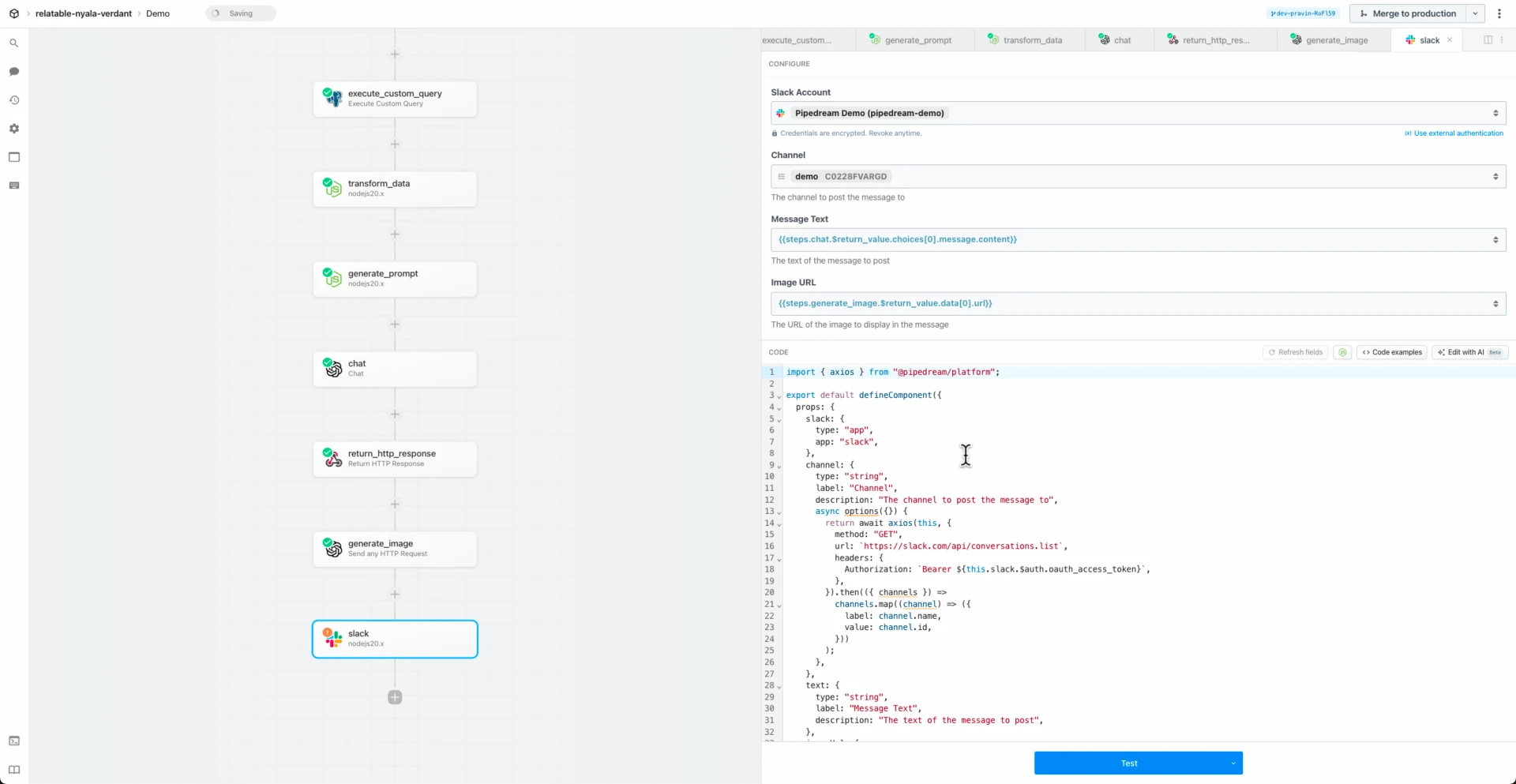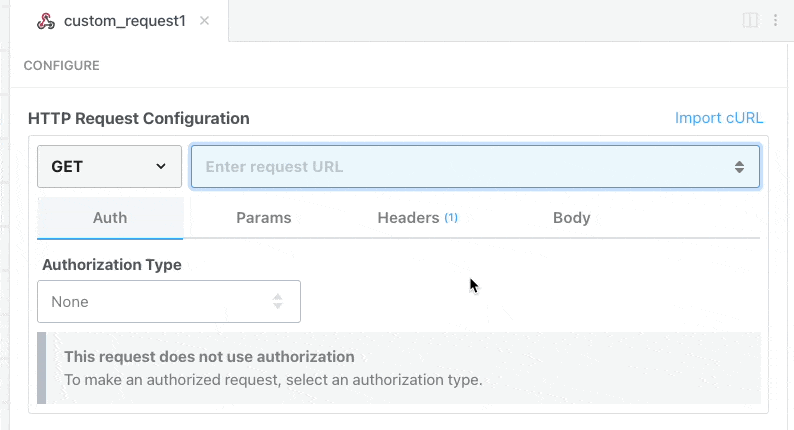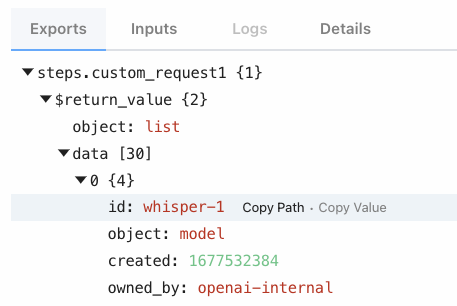actions/validate-webhook-auth/validate-webhook-auth.mjs
import http from "../../http.app.mjs"; export default { name: "Validate Webhook Auth", version: "0.0.5", annotations: { destructiveHint: false, openWorldHint: true, readOnlyHint: false, }, key: "http-validate-webhook-auth", description: "Require authorization for incoming HTTP webhook requests. Make sure to configure the HTTP trigger to \"Return a custom response from your workflow\".", type: "action", props: { http, authInput: { type: "string", label: "Authorization Value to Authenticate", description: "Select the location of the authorization value to check. For example, if you're looking for a Bearer token on the inbound webhook request, set this to `{{steps.trigger.event.body.headers.authorization}}`.", default: "{{steps.trigger.event.headers.authorization}}", }, customResponse: { type: "boolean", label: "Return Error to Webhook Caller", description: "If `True`, returns a `401: Invalid credentials` error in the case of invalid authorization. **Make sure to configure the HTTP trigger to \"Return a custom response from your workflow\"**. If `False`, does not return a custom response in the case of invalid auth.", default: true, }, authType: { type: "string", label: "Authorization Type", description: "Select the Authorization Type for the incoming webhook.", reloadProps: true, options: [ { label: "Basic Auth", value: "basic", }, { label: "Bearer Auth", value: "bearer", }, { label: "Key-Based Auth", value: "key", }, ], }, }, async additionalProps() { const props = {}; switch (this.authType) { case "basic": props.basicAuthUsername = { type: "string", label: "Username", description: "Enter your username or reference an environment variable. For example, `{{process.env.username}}`.", }; props.basicAuthPassword = { type: "string", label: "Password", description: "Enter your password or reference an environment variable. For example, `{{process.env.password}}`.", secret: true, }; break; case "bearer": props.bearer = { type: "string", label: "Bearer Token", description: "Enter your Bearer Token or reference an environment variable. For example, `{{process.env.token}}`. **Make sure to include any prepended values**, like `Bearer` for example.", }; break; case "key": props.key = { type: "string", label: "API Key", description: "Enter your API Key or reference an environment variable. For example, `{{process.env.api_key}}`.", secret: true, }; break; default: } return props; }, async run({ $ }) { const authType = this.authType; const authInput = this.authInput; let basicString = ""; if (authType === "basic") { const un = this.basicAuthUsername; const pw = this.basicAuthPassword; const str = `${un}:${pw}`; const buff = Buffer.from(str, "utf-8"); basicString = `Basic ${buff.toString("base64")}`; } const authValue = this.bearer ?? this.key ?? basicString; if (authInput !== authValue) { if (this.customResponse) { await $.respond({ status: 401, headers: {}, body: "Invalid credentials", }); } if ($.flow) { return $.flow.exit("Invalid credentials"); } else { throw new Error("Invalid credentials"); } } $.export("$summary", "HTTP request successfully authenticated"); }, };
 Chase Roberts@chsrbrts@benedictevans If you haven’t used @pipedream yet, then you haven’t lived.
Chase Roberts@chsrbrts@benedictevans If you haven’t used @pipedream yet, then you haven’t lived. ✨Ellie Day✨@heyelliedayEvaluation update: @pipedream has quite literally been a dream to work with! I’m excited to leverage this tool for all the various workflows I need to write. I’m currently at 11k invocations a day from the initial workflows I’ve written in the past couple weeks.
✨Ellie Day✨@heyelliedayEvaluation update: @pipedream has quite literally been a dream to work with! I’m excited to leverage this tool for all the various workflows I need to write. I’m currently at 11k invocations a day from the initial workflows I’ve written in the past couple weeks. Michael Braedley@MBraedleyUpdate: I got it working properly, and it's working so well that I'm dropping IFTTT. @pipedream can do everything that IFTTT basic can, and most (if not all things) IFTTT pro can for free or at a reasonable price if you need it. I am recommending it for basically any power user.
Michael Braedley@MBraedleyUpdate: I got it working properly, and it's working so well that I'm dropping IFTTT. @pipedream can do everything that IFTTT basic can, and most (if not all things) IFTTT pro can for free or at a reasonable price if you need it. I am recommending it for basically any power user. Thomas Cutting@mrthomascuttingWant quick+dirty integrations for a serverless workflow - @pipedream is my new go-to 😃
Thomas Cutting@mrthomascuttingWant quick+dirty integrations for a serverless workflow - @pipedream is my new go-to 😃 Matthew Roberts@mattdotrobertsday 013 - finally hit node js. This is the secret sauce of taking #nocode projects that one step further. Pumped about getting deeper into @pipedream now
Matthew Roberts@mattdotrobertsday 013 - finally hit node js. This is the secret sauce of taking #nocode projects that one step further. Pumped about getting deeper into @pipedream now Kenneth Auchenberg 💭@auchenbergYahoo Pipes is back! Kinda 😍 @pipedream
Kenneth Auchenberg 💭@auchenbergYahoo Pipes is back! Kinda 😍 @pipedream Raymond Camden 🥑@raymondcamdenAwesome video by the @pipedream folks showing real time twitter sentiment analysis integrated with Google Sheets. This is where Pipedream *really* shines, connecting systems together in easy workflows.
Raymond Camden 🥑@raymondcamdenAwesome video by the @pipedream folks showing real time twitter sentiment analysis integrated with Google Sheets. This is where Pipedream *really* shines, connecting systems together in easy workflows. Nacho Caballero@nachocaballeroI couldn't recommend @pipedream more. It's an amazing service to integrate different APIs. Much more powerful than Zapier and more user-friendly than AWS Lambda. I'm very proud to wear this t-shirt #NoCode
Nacho Caballero@nachocaballeroI couldn't recommend @pipedream more. It's an amazing service to integrate different APIs. Much more powerful than Zapier and more user-friendly than AWS Lambda. I'm very proud to wear this t-shirt #NoCode Jason Snow@jyksnwDeveloped a working prototype environmental sensor IoT solution with @particle Photon, @pipedream, and @MongoDB with full graphing and alerting in less than a day! All amazing technology, will def. be exploring these more.
Jason Snow@jyksnwDeveloped a working prototype environmental sensor IoT solution with @particle Photon, @pipedream, and @MongoDB with full graphing and alerting in less than a day! All amazing technology, will def. be exploring these more. Steven Terrana@steven_terrana@burgwyn you've inspired me to finally set up my own blog. I'll make sure my first blog post explains the tech behind the setup. think @obsdmd + @GatsbyJS + @pipedream.
Steven Terrana@steven_terrana@burgwyn you've inspired me to finally set up my own blog. I'll make sure my first blog post explains the tech behind the setup. think @obsdmd + @GatsbyJS + @pipedream. 🚄 James Augeri, PhD@DotDotJamesWant to low-code your back end, need more horsepower than @Bubble / @KnackHQ, or just miss Yahoo! Pipes? Check out @PipeDream
🚄 James Augeri, PhD@DotDotJamesWant to low-code your back end, need more horsepower than @Bubble / @KnackHQ, or just miss Yahoo! Pipes? Check out @PipeDream Sébastien Chopin@AtinuxGitHub issues should be like @linear_app for maintainers. Looking forward more integrations with GH actions or tools like @pipedream 👀
Sébastien Chopin@AtinuxGitHub issues should be like @linear_app for maintainers. Looking forward more integrations with GH actions or tools like @pipedream 👀 Raul@raul_predescuIf you're a dev and not using @pipedream, you're missing out. Been using it for months, daily. FREE for devs. Plenty of integrations and good limits. Absolutely love it.
Raul@raul_predescuIf you're a dev and not using @pipedream, you're missing out. Been using it for months, daily. FREE for devs. Plenty of integrations and good limits. Absolutely love it. Bruno Skvorc@bitfallsSo @pipedream is pretty amazing. In 3 minutes I just made a flow which adds @rickastley's Never Gonna Give You Up to my @spotify playlist whenever a new pull request arrives in an old repo of mine.
Bruno Skvorc@bitfallsSo @pipedream is pretty amazing. In 3 minutes I just made a flow which adds @rickastley's Never Gonna Give You Up to my @spotify playlist whenever a new pull request arrives in an old repo of mine. Zach Lanich@ZachLanichUm, wow 🤯 @pipedream
Zach Lanich@ZachLanichUm, wow 🤯 @pipedream Steven Bell@bellontechI just used @pipedream to build a Shopify App. Wow, they make small backed tasks easy.
Steven Bell@bellontechI just used @pipedream to build a Shopify App. Wow, they make small backed tasks easy. Jay Hack 🎩🇺🇸@_jayhack_Very impressed with this bad boi - it reminds me of a @PalantirTech internal tool, but geared towards integrations instead of data analysis and far more customizable. Great expectations here 🚀🤩
Jay Hack 🎩🇺🇸@_jayhack_Very impressed with this bad boi - it reminds me of a @PalantirTech internal tool, but geared towards integrations instead of data analysis and far more customizable. Great expectations here 🚀🤩 Tree Sturgeon 🔥🚴♂️🌳@philsturgeonFor context this is day 2 of a really challenging and stupid migration from Notion to @airtable with disparate/missing data. It's going better than expected and thanks to @pipedream I don't have to bother the iOS dev to add W3W.
Tree Sturgeon 🔥🚴♂️🌳@philsturgeonFor context this is day 2 of a really challenging and stupid migration from Notion to @airtable with disparate/missing data. It's going better than expected and thanks to @pipedream I don't have to bother the iOS dev to add W3W.




